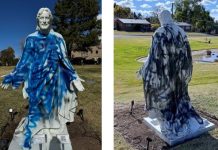
March 11 (UPI) — Archaeologists found parts of a statue believed to be of King Ramses II, who ruled Egypt 3,000 years ago, at a Cairo archaeological dig, the Egyptian Antiquities Ministry announced.
Two sections — a head and a torso — were discovered last week in ground water by a German-Egyptian archaeological mission in Matariya, a suburb of Cairo. Around 1200 B.C., the king built a temple there when the city was known as Heliopolis.
Antiquities Minister Khaled al-Anani called the discovery among the most important of recent archaeological finds, demonstrating the magnitude of the temple and the artistic quality of the work.
“Last Tuesday they called me to announce the big discovery of a colossus of a king, most probably Ramses II, made out of quartzite,” he said.
Ramses’ head was lifted from the water with a crane. Dietrich Raue, leader of the archeological project, said the head is in a good state of preservation and was removed unharmed; previous reports suggested it was damaged by heavy machinery used to excavate it.
More parts of the statue remain at the site and will be removed from the clay and ground water in which they are buried, Mahmoud Afify of the Egyptian Antiquities Sector said.





